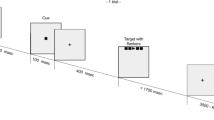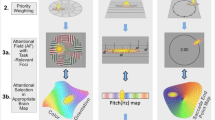Abstract
Although migraine is traditionally categorized as a primary headache disorder, the condition is also associated with abnormalities in visual attentional function in between headache events. Namely, relative to controls, migraineurs show both a heightened sensitivity to nominally unattended visual events, as well as decreased habituation responses at sensory and post-sensory (cognitive) levels. Here we used event-related potentials (ERPs) to examine whether cortical hypersensitivities in migraineurs extend to mind wandering, or periods of time wherein we transiently attenuate the processing of external stimulus inputs as our thoughts drift away from the on-going task at hand. Participants performed a sustained attention to response task while they were occasionally queried as to their attentional state—either “on-task” or “mind wandering.” We then analyzed the ERP responses to task-relevant stimuli as a function of whether they immediately preceded an on-task versus mind wandering report. We found that despite the commonly reported heightened visual sensitivities in our migraine group, they nevertheless manifest a reduced cognitive response during periods of mind wandering relative to on-task attentional states, as measured via amplitude changes in the P3 ERP component. This suggests that our capacity to attenuate the processing of external stimulus inputs during mind wandering is not necessarily impaired by the class of cortical hypersensitivities characteristic of the interictal migraine brain.



Similar content being viewed by others
References
Antal A, Temme J, Nitsche M, Varga E, Lang N, Paulus W (2005) Altered motion perception in migraineurs: evidence for interictal cortical hyperexcitability. Cephalalgia 25(10):788–794. doi:10.1111/j.1468-2982.2005.00949.x
Barron E, Riby L, Greer J, Smallwood J (2011) Absorbed in thought: the effect of mind wandering of the processing of relevant and irrelevant events. Psychol Sci 22(5):596–601
Brighina F, Palermo A, Fierro B (2009) Cortical inhibition and habituation to evoked potentials: relevance for pathophysiology of migraine. J Headache Pain 10(2):77–84. doi:10.1007/s10194-008-0095-x
Carriere JS, Seli P, Smilek D (2013) Wandering in both mind and body: individual differences in mind wandering and inattention predict fidgeting. Can J Exp Psychol 67:13–31. doi:10.1037/a0031438
Cheyne JA, Carriere JS, Smilek D (2006) Absent-mindedness: lapses of conscious awareness and everyday cognitive failures. Conscious Cogn 15:578–592
Christoff K, Gordon AM, Smallwood J, Smith R, Schooler JW (2009) Experience sampling during fMRI reveals default network and executive system contributions. Proc Natl Acad Sci USA 106(21):8719–8724
Coppola G, Pierelli F, Schoenen J (2009) Habituation and migraine. Neurobiol Learn Mem 92(2):249–259. doi:10.1016/j.nlm.2008.07.006
Delorme A, Makeig S (2004) EEGLAB: an open source toolbox for analysis of single trial EEG dynamics including independent component analysis. J Neurosci Methods 134:9–21
Evers S, Bauer B, Suhr B, Husstedt I, Grotemeyer K (1997) Cognitive processing in primary headache: a study on event-related potentials. Neurology 48(1):108–113
Evers S, Bauer B, Grotemeyer K, Kurlemann G, Husstedt I (1998) Event-related potentials (P300) in primary headache in childhood and adolescence. J Child Neurol 13(7):322–326
Evers S, Quibeldey F, Grotemeyer K, Suhr B, Husstedt I (1999) Dynamic changes of cognitive habituation and serotonin metabolism during the migraine interval. Cephalalgia 19(5):485–491. doi:10.1046/j.1468-2982.1999.019005485.x
Franklin MS, Smallwood J, Schooler JS (2011) Catching the mind in flight: using behavioral indices to detect mindless reading in real time. Psychon Bull Rev 18:992–997
Fumal A, Coppola G, Bohotin V, Gerardy P, Seidel L, Donneau A, Schoenen J (2006) Induction of long-lasting changes of visual cortex excitability by five daily sessions of repetitive transcranial magnetic stimulation (rTMS) in healthy volunteers and migraine patients. Cephalalgia 26(2):143–149. doi:10.1111/j.1468-2982.2005.01013.x
Giffin NJ, Kaube H (2002) The electrophysiology of migraine. Curr Opin Neurol 15(3):303–309
Groves PM, Thompson RF (1970) Habituation: a dual-process theory. Psychol Rev 77(5):419–450
Handy T, Khoe W (2005) Attention and sensory gain control: a peripheral visual process? J Cogn Neurosci 17(12):1936–1949. doi:10.1162/089892905772008715
Headache Classification Subcommittee of the International Headache Society (2004) The international classification of headache disorders: 2nd edition. Cephalalgia 24:9–160
Kam JWY, Handy TC (2013) The neurocognitive consequences of the wandering mind: a mechanistic account of sensory-motor decoupling. Front Psychol. doi:10.3389/fpsyg.2013.00725
Kam JWY, Dao E, Farley J, Fitzpatrick K, Smallwood J, Schooler JW, Handy TC (2011) Slow fluctuations in attentional control of sensory cortex. J Cogn Neurosci 23:460–470
Kam JWY, Dao E, Blinn P, Krigolson OE, Boyd LA, Handy TC (2012) Mind wandering and motor control: off-task thinking disrupts the online adjustment of behavior. Front Hum Neurosci 6:329. doi:10.3389/fnhum.2012.00329
Kam JWY, Dao E, Stanciulescu M, Tildesley H, Handy TC (2013) Mind wandering and the adaptive control of attentional resources. J Cogn Neurosci 25:952–960
Kam JWY, Xu J, Handy TC (2014) I don’t feel your pain (as much): the desensitizing effect of mind wandering on the perception of others’ discomfort. Cogn Affect Behav Neurosci 14:286–296
Kirschner A, Kam JWY, Handy TC, Ward LM (2012) Differential synchronization in default and task-specific networks of the human brain. Frontiers in Hum Neurosci 21(6):139. doi:10.3389/fnhum.2012.00139
Mason MF, Norton MI, Van Horn JD, Wegner DM, Grafton ST, Macrae CN (2007) Wandering minds: the default network and stimulus-independent thought. Science 315:393–395
McKiernan KA, D’Angelo BR, Kaufman JN, Binder JR (2006) Interrupting the “stream of consciousness”: an fMRI investigation. NeuroImage 29:1185–1191
McVay JC, Kane MJ (2009) Conducting the train of thought: working memory capacity, goal neglect, and mind wandering in an executive-control task. J Exp Psychol Learn Mem Cogn 35:196–204
Mickleborough MJS, Hayward J, Chapman C, Chung J, Handy TC (2011a) Reflexive attentional orienting in migraineurs: the behavioral implications of hyperexcitable visual cortex. Cephalalgia 31:1642–1651
Mickleborough MJS, Truong G, Handy TC (2011b) Top-down attentional control of visual cortex in migraine populations. Neuropsychologia 49:1006–1015
Mickleborough MJS, Chapman CM, Toma AS, Chan JHM, Truong G, Handy TC (2013) Interictal neurocognitive processing of visual stimuli in migraine: evidence from event-related potentials. PLoS One 8(11):e80920. doi:10.1271/J.pone.0080920
Mickleborough MJS, Chapman CM, Toma AS, Chan JHM, Handy TC (2014) Cognitive processing of visual images in migraine populations in between headache attacks. Brain Res. doi:10.1016/j.brainres.2014.07.031
O’Connell RG, Dockree PM, Robertson IH, Bellgrove MA, Foxe JJ et al (2009) Uncovering the neural signature of lapsing attention: electrophysiological signals predicts errors up to 20 s before they occur. J Neurosci 29:8604–8611
Obrien B, Goeree R, Streiner D (1994) Prevalence of migraine headache in Canada—a population-based survey. Int J Epidemiol 23(5):1020–1026
Robertson IH, Manly T, Andrade J, Baddeley BT, Yiend J (1997) “Oops!”: performance correlates of everyday attentional failures in traumatic brain injured and normal subjects. Neuropsychologia 35:747–758
Sacks O (1992) Migraine. Vintage Books, New York
Schad DJ, Nuthmann A, Engbert R (2012) Your mind wanders weakly, your mind wanders deeply: objective measures reveal mindless reading at different levels. Cognition 125:179–194
Schooler JW, Reichle ED, Halpern DV (2004) Zoning-out during reading: evidence for dissociations between experience and meta-consciousness. In: Levin DT (ed) Thinking and seeing: visual metacognition in adults and children. MIT Press, Cambridge, pp 204–226
Seli P, Carriere JS, Smilek D (2014) Not all mind wandering is created equal: dissociating deliberate and spontaneous mind wandering. Psychol Res. doi:10.1007/s00426-014-0617-x
Seli P, Smallwood J, Cheyne JA, Smilek D (2015) On the relation of mind wandering and ADHD symptomatology. Psychon Bull Rev. doi:10.3758/s13423-014-0793-0
Smallwood J, Baracaia SF, Lowe M, Obonsawin M (2003) Task unrelated thought whilst encoding information. Conscious Cogn 12:452–484
Smallwood J, Davies JB, Heim D, Finnigan F, Sudberry M, O’Connor R et al (2004) Subjective experience and the attentional lapse: task engagement and disengagement during sustained attention. Conscious Cogn 13:657–690
Smallwood J, Schooler JW (2006) The restless mind. Psychol Bull 132(6):946–958
Smallwood J, Riby D, Heim D, Davies J (2006) Encoding during the attentional lapse: accuracy of encoding during the semantic sustained attention to response task. Conscious Cogn 15:218–231
Smallwood J, Beach E, Schooler JW, Handy TC (2008a) Going AWOL in the brain: mind wandering reduces cortical analysis of external events. J Cogn Neurosci 20:458–469
Smallwood J, McSpadden M, Schooler JW (2008b) When attention matters: the curious incident of the wandering mind. Mem Cogn 36:1144–1150
Stankewitz A, May A (2009) The phenomenon of changes in cortical excitability in migraine is not migraine-specific—a unifying thesis. Pain 145(1–2):14–17. doi:10.1016/j.pain.2009.03.010
Stawarczyk D, Majerus S, Maquet P, D’Argembeau A (2011) Neural correlates of ongoing conscious experience: both task-unrelatedness and stimulus-independence are related to default network activity. PLoS One 6:e16997. doi:10.1371/J.pone.0016997
Thomson DR, Smilek D, Besner D (2014) On the asymmetric effects of mind-wandering on levels of processing at encoding and retrieval. Psychol Bull Rev 21(3):728–733
Wagner D, Manahilov V, Loffler G, Gordon GE, Dutton GN (2010) Visual noise selectively degrades vision in migraine. Invest Ophthalmol Vis Sci 51(4):2294–2299. doi:10.1167/iovs.09-4318
Acknowledgments
We sincerely thank all our participants for their time and effort in our study. J.W.Y.K. and T.C.H. are supported by the Natural Sciences and Engineering Research Council. M.J.S.M. is supported by the Saskatchewan Health Research Foundation.
Conflict of interest
All authors have no conflict of interest to declare.
Ethical standard
All procedures performed in studies involving human participants were in accordance with the ethical standards of the institutional and/or national research committee and with the 1964 Helsinki declaration and its later amendments or comparable ethical standards.
Author information
Authors and Affiliations
Corresponding author
Rights and permissions
About this article
Cite this article
Kam, J.W.Y., Mickleborough, M.J.S., Eades, C. et al. Migraine and attention to visual events during mind wandering. Exp Brain Res 233, 1503–1510 (2015). https://doi.org/10.1007/s00221-015-4224-x
Received:
Accepted:
Published:
Issue Date:
DOI: https://doi.org/10.1007/s00221-015-4224-x




